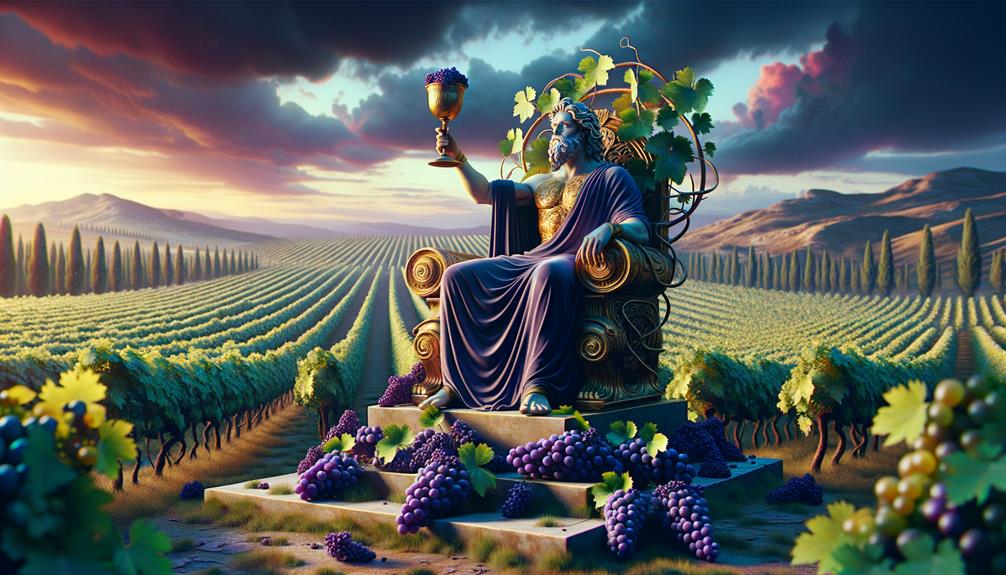Dionysus, the Greek god of wine**, fertility, and ecstasy, is a fascinating figure in ancient mythology. His parentage is unique – he is the offspring of Zeus, king of the gods, and Semele, a mortal princess. This unique lineage makes him known as the ‘twice-born deity**’.
The symbols associated with Dionysus – like ripening grapevines and the thyrsos – represent joy and indulgence. His stories take us on voyages across different lands, sharing the art of winemaking and establishing him as the god of wine. However, Dionysus wasn’t just about parties and intoxication. His worship also symbolized societal freedom, as seen in the secretive rituals of the Dionysian Mysteries.
We can learn so much about the intertwining of wine with ancient society and religion by delving into Dionysus’ story. Understanding more about Dionysus helps us to appreciate the multifaceted nature of his influence and role as a deity.
Origin and Birth of Dionysus
Let’s chat about the fascinating birth and roots of Dionysus, a unique character in Greek mythology. This god, full of complexities, was the child of Zeus and a mortal princess named Semele. His birth was quite a tale! Semele passed away prematurely, which prompted Zeus to place the unborn Dionysus into his thigh until he was ready to be born – earning him the title of the ‘twice-born deity‘.
Dionysus had a unique childhood. He grew up in the secluded Mount Nysa, looked after by nurturing nymphs, because of Hera’s revenge-driven madness. However, when Hera’s jealousy reached a peak, Dionysus had to leave his safe haven and wander through numerous regions. Here’s a fun fact: he was even turned into a ram once for protection! These peculiar beginnings greatly shaped Dionysus’s character and his enduring legacy in Greek mythology.
Dionysus Symbols and Attributes
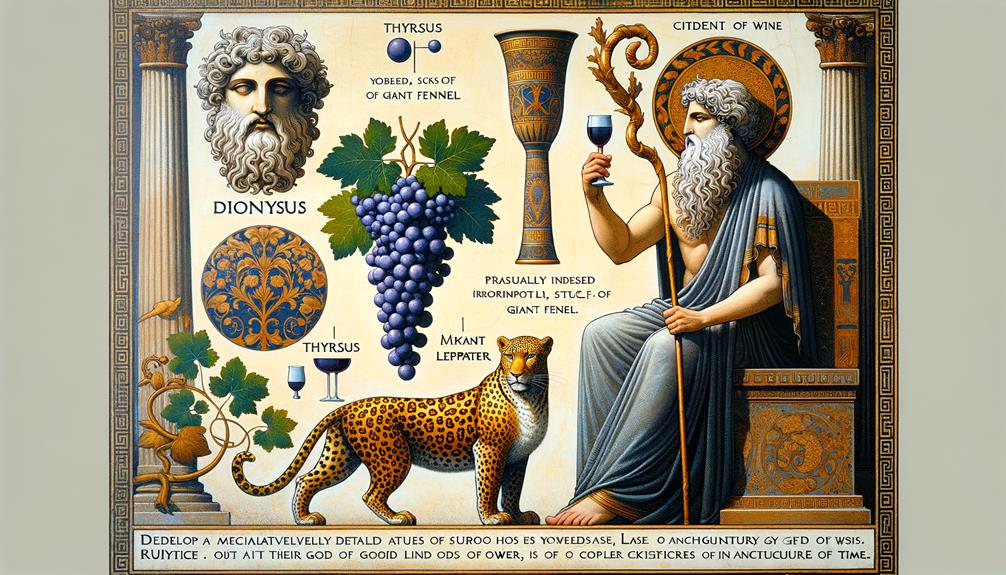
Dionysus, a fascinating figure in Greek mythology, is often depicted with a variety of unique symbols in various forms of art, such as early Greek art, paintings using oil on canvas, and marble statues. One of his most recognizable symbols is the thyrsos, a staff tipped with a pine cone, symbolizing power and fertility. Other symbols you might see associated with Dionysus include fruiting grapevines, a drinking cup made of clay, and a panther sculpture.
| Symbol | Material | Interpretation |
|---|---|---|
| Thyrsos | Pine-cone | Power and fertility |
| Drinking-cup | Clay | Celebration and wine |
| Ivy-leaves | Wreath | Immortality |
| Panther | Sculpture | Strength and ferocity |
Typically, Dionysus is portrayed wearing a long robe and cloak, with a wreath of ivy-leaves crowning his head. This attire is a nod to his divine status and his link to wine. The symbols and attire associated with Dionysus are a significant part of his myth and persona, adding an extra layer of depth to this intriguing character from Greek mythology.
Dionysus Adventures and Wine Invention
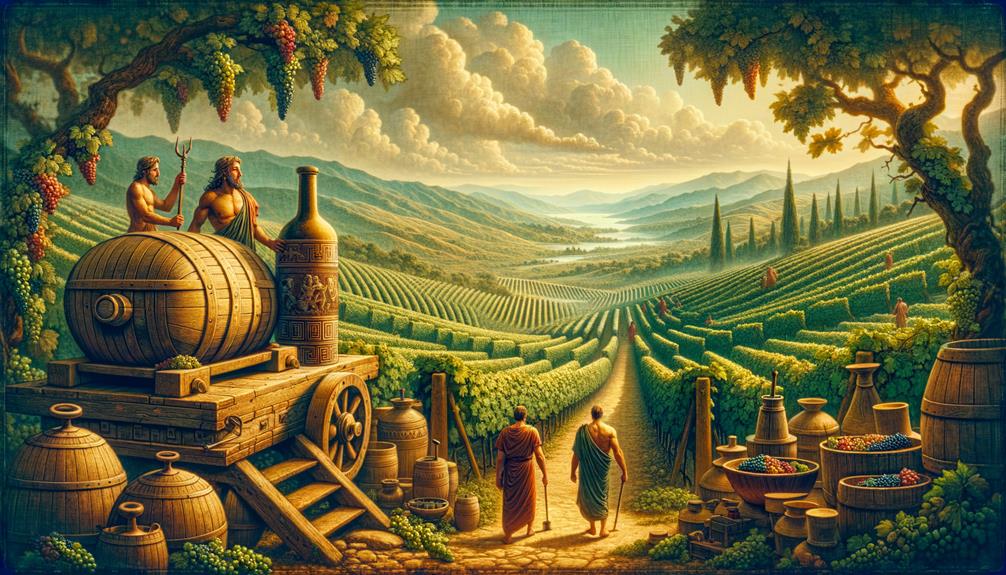
Dionysus’s epic journey took him to numerous countries, like Egypt, Syria, and Asia. Everywhere he went, he didn’t just conquer his enemies but also spread the culture of growing vines and honoring the gods. His victories were about more than just winning battles; they were about civilizing societies. He even went as far as teaching his Indian prisoners about wine production and the secrets of his religious group, which helped shape their community.
In Phrygia, a place in modern-day Turkey, the goddess Cybele cleansed Dionysus, which made his godly nature even stronger. His confrontations with the Amazons, Titans, and Tyrrhenian pirates were a testament to his strength and his divine powers’ resilience. The fact that he could turn pirates into dolphins shows not only his anger but also his deep bond with nature.
All these adventures were more than just tales of heroism. They cemented Dionysus’s place as a deity who introduced civilization to people and as the undisputed wine god of Greek mythology.
Worship and Festivities of Dionysus
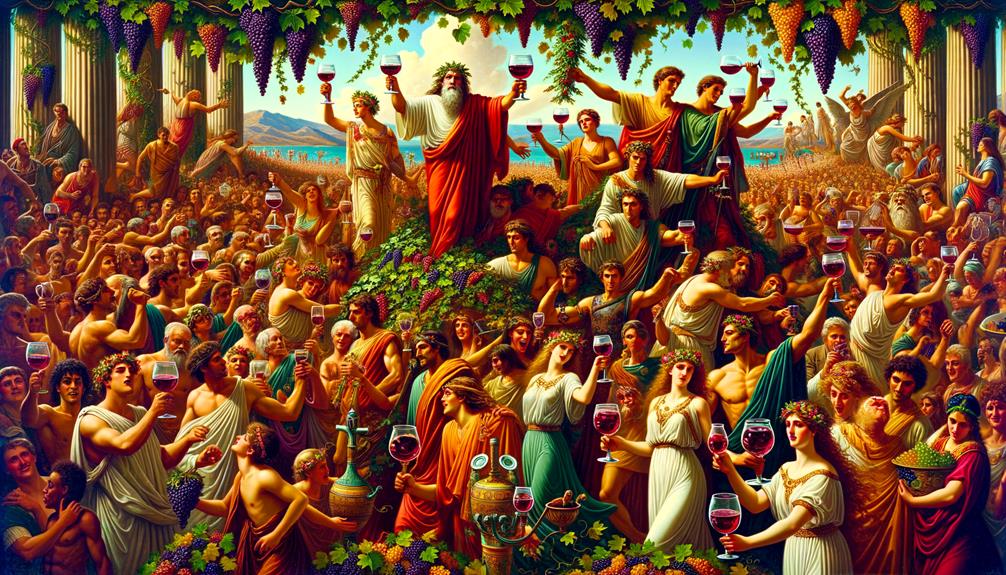
Let’s chat about the ‘Worship and Festivities of Dionysus’. It’s key to get a handle on the special rituals and ceremonies that were part of paying him respect. The festivals thrown in his name, notably the Great Dionysia and the Roman Bacchanalia, were more than just parties. They were deeply symbolic affairs that give us a glimpse into the religious customs of ancient Greek and Roman societies. We’re going to break down these practices, with a focus on the importance of wine, ecstatic dances, and the theme of liberation in Dionysus’ worship.
Dionysian Rituals and Ceremonies
When it comes to Dionysus, the Greek god known for his association with wine, many rituals and ceremonies were carried out. These activities often involved wild dancing, music, and, of course, plenty of wine. These elements reflected the transformative power Dionysus was believed to possess.
The rituals linked to Dionysus weren’t just about paying respect to the god. They were also about expressing the complexities and depths of what it means to be human. Now, let’s talk about some of the key aspects of these rituals:
First off, have you heard of the Maenads? They were the female followers of Dionysus and were known for their wild dances and the ecstatic states they could reach.
Next, there were the Dionysian Mysteries. These were secretive rituals that symbolized liberation and breaking societal norms. These mysteries spread all throughout the Mediterranean region, making their mark on various cultures.
Last but not least, there was the Great Dionysia. This was a festival where dramatic performances dedicated to Dionysus were held.
Dionysus Festival Significance
When we take a closer look at the celebrations dedicated to Dionysus, it’s clear that these gatherings, especially the Dionysia in Athens, were a big deal in Greek society. They weren’t just about honouring the god of wine, either. These events were super important in shaping dramatic performances as we know them today. The Dionysia and other similar fetes had it all – from wild rites to theatrical shows to a real sense of community worship.
It’s interesting to note that women were especially attracted to Dionysus’ following. They weren’t just spectators – they were right there in the thick of the rituals and parties. Through their focus on drama and performance, these events had a massive impact on the growth of Greek theatre. And the significance of Dionysus’ festivals? Well, they were about much more than just paying homage to a god.
Worship Practices in Detail
Dionysus, the son of Zeus, was a deity held in high esteem in ancient times. His worship was celebrated with a host of interesting and influential rituals, ceremonies, and festivals. Drama was a key element in these celebrations, particularly during the Dionysian festivals.
- A group of women, known as the Maenads, were particularly devoted to Dionysus. They would participate in intense rituals that often involved the use of a thyrsus staff, an emblem of Dionysian worship.
- The Dionysian Mysteries were secret rituals that gave participants a sense of freedom. These rites allowed them to break free from societal norms.
- The act of worshiping Dionysus also included offerings of wine and ivy wreaths. These tokens underscored Dionysus’s connection with nature and his role as the god of intoxication.
These practices served to solidify Dionysus’s position as the god of wine, festivity, and freedom. They also had a significant impact on Greek art, literature, and religious traditions.
Dionysus in Classical and Modern Art
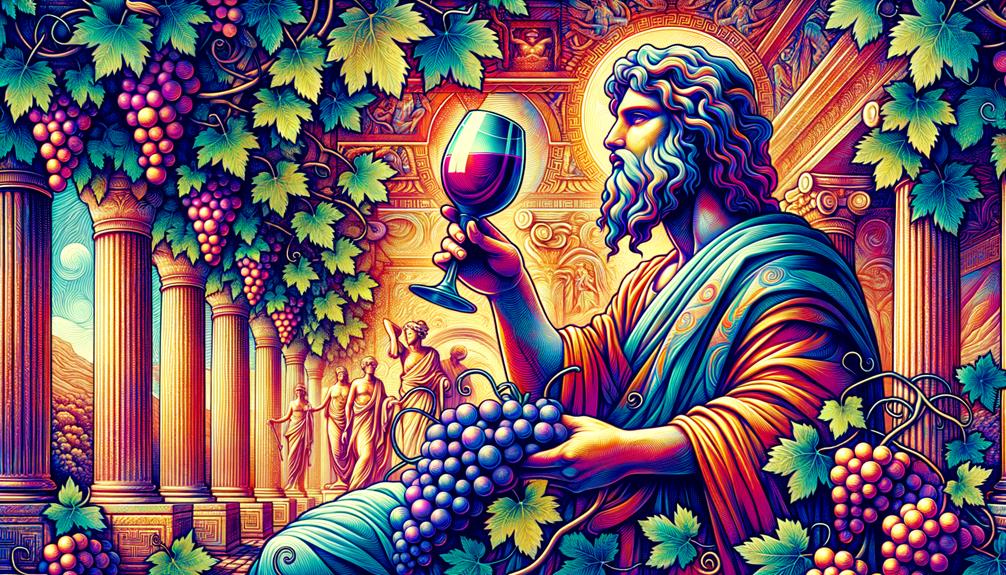
When we talk about art, it’s impossible to ignore Dionysus. This character has been a popular choice for artists, always recognized by his classic symbols such as the thyrsus, an ivy wreath, and a drinking cup. In Greek mythology, Dionysus is the god of fertility, often linked to wine and ecstatic states – a clear reflection of the intense celebrations and enthusiasm associated with the Bacchic cult.
Artists, spanning from the classical to modern periods, have skillfully integrated these elements into their work. The result? Art pieces that offer fascinating narratives and deepen our understanding of Dionysus’ role and impact. These works of art now reside in museums, serving as a bridge between the past and the present, and they continue to captivate and pique curiosity. The prevalence of Dionysus in art stands as vibrant evidence of his lasting cultural relevance.
Parallels Between Dionysus and Christianity
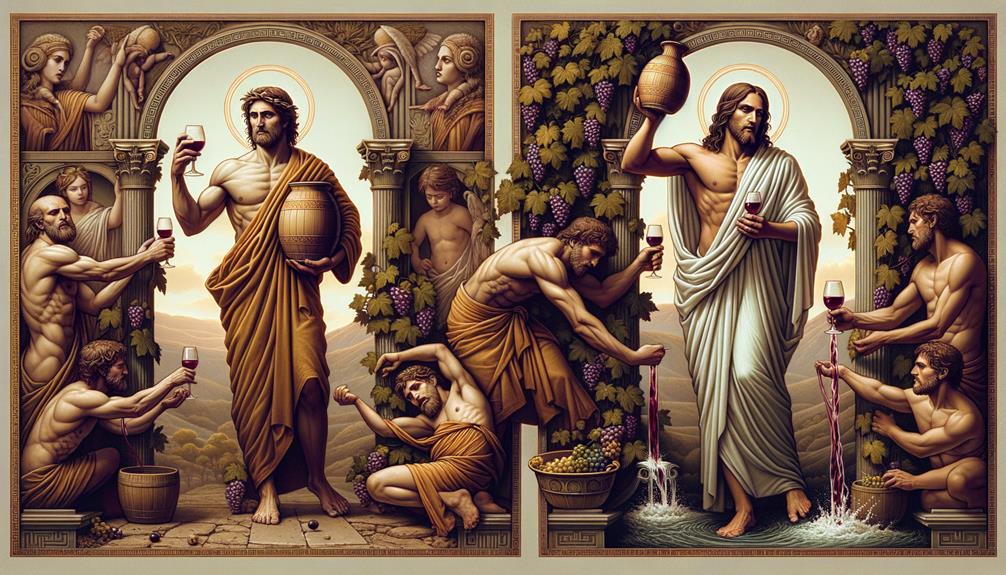
Even though Dionysus and Jesus come from very different backgrounds, when we take a closer look at their stories, we can’t help but notice some striking similarities. They both have a special connection with wine and are known to perform miracles like turning water into wine.
First off, Dionysus, born to Semele, was the Greek god of wine and partying. His followers, known as the Dionysus cult, would partake in secret rituals and feastings, which might remind you of the Last Supper in Christianity.
Next up is the symbolism of blood and wine that is evident in both traditions. This connection links Dionysus’ ability to change things with the spiritual aspects of Christianity.
Lastly, both stories have a strong theme of rebirth and resurrection, which further ties in with their shared symbolism of wine.
These similarities could give us a fresh perspective on how these different traditions could be connected at a deeper cultural level.
Frequently Asked Questions
Was Dionysus a God of Wine?
Absolutely, Dionysus is indeed recognized as the God of Wine according to Greek mythology. He’s the one linked to the growth of vines and the merry celebrations that involve drinking wine, representing happiness, wild pleasure, and freedom. His festivals were commonly marked by the ritualistic act of enjoying wine.
Who Is the Greek God of Food and Wine?
Sure, let’s chat about Greek mythology. Did you know that Dionysus is the god of food and wine? That’s right! This god isn’t just about the good times, though. Dionysus also takes care of orchards, celebrations, and fertility. So, he’s got quite a bit on his divine plate, wouldn’t you agree?
Who Is the Greek God of Wine and Intoxication?
Did you know that Dionysus is the Greek god responsible for wine and getting tipsy? But that’s not all! He’s also associated with things like fertility, plants, and even the theater. In fact, the parties thrown by his followers were quite the spectacle and played a huge role in shaping Greek theater and festivals as we know them. So, pour a glass and raise a toast to Dionysus, our multifaceted god of wine!
Who Is the God of Wine Roman God?
Have you ever wondered who the Romans worshipped as their god of wine? Well, it’s Bacchus. He was a pretty big deal, known for his wild parties and the sheer joy he brought to those festivities. If you look at Roman art, you’ll often see him surrounded by grapevines, cups, and even panthers. These symbols all speak to his influence and importance in Roman society.

